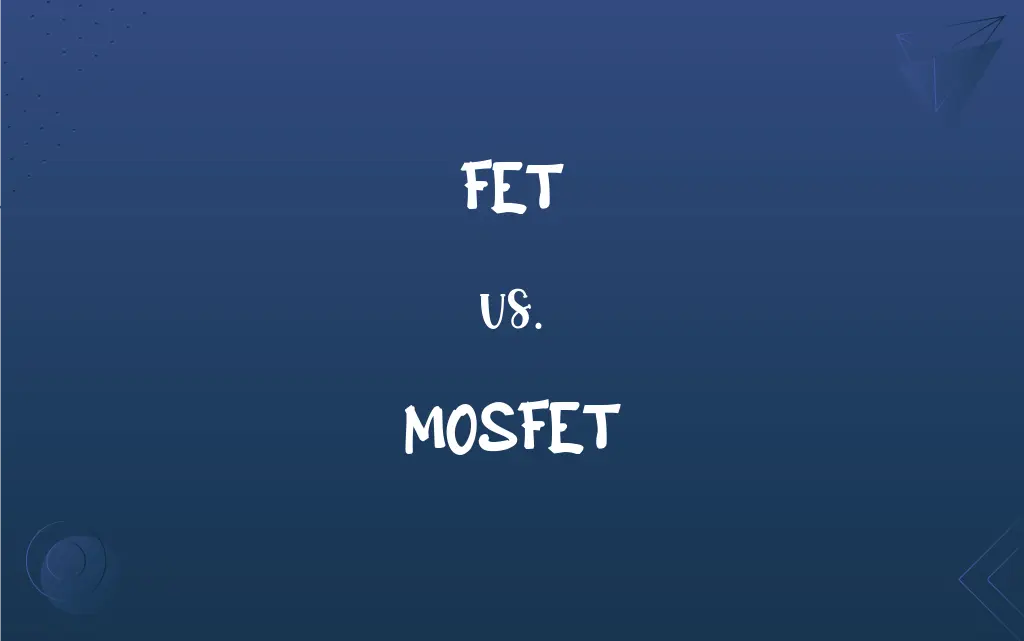FET vs. MOSFET: What's the Difference?
Edited by Aimie Carlson || By Janet White || Published on February 23, 2024
FET (Field-Effect Transistor) is a transistor controlled by voltage, while MOSFET (Metal-Oxide Semiconductor Field-Effect Transistor) is a specific type of FET with a metal-oxide gate.

Key Differences
A Field-Effect Transistor (FET) is a type of transistor that uses an electric field to control the flow of current. A MOSFET, which stands for Metal-Oxide Semiconductor Field-Effect Transistor, is a specific kind of FET that offers high efficiency and is widely used in electronic circuits.
FETs are characterized by their voltage-controlled operation, using the electric field between their source and gate terminals. In contrast, MOSFETs include an additional oxide layer between the gate and the body, which enhances their performance by reducing gate current.
All MOSFETs are FETs, not all FETs are MOSFETs. FETs encompass a broader category of transistors, including JFETs (Junction Field-Effect Transistors), whereas MOSFETs are distinguished by their specific structure and function.
FETs are known for their high input impedance, making them suitable for weak signal amplification. MOSFETs extend these benefits with their enhanced control and efficiency, making them ideal for power applications and digital circuits.
The key difference lies in their construction and operation: FETs use junctions and electric fields for control, while MOSFETs use a metal-oxide insulation layer, providing greater efficiency and control in electronic applications.
ADVERTISEMENT
Comparison Chart
Basic Definition
A transistor controlled by voltage.
A specific type of FET with a metal-oxide gate.
Gate Structure
Uses semiconductor materials.
Includes a metal-oxide insulation layer.
Current Flow Control
Controlled by electric field between source and gate.
Controlled by voltage applied to the metal-oxide gate.
Types
Includes JFETs, among others.
A specialized form of FET.
Primary Applications
Suitable for amplifying weak signals.
Widely used in digital circuits and power applications.
ADVERTISEMENT
FET and MOSFET Definitions
FET
An electronic device that operates primarily on field effect.
In his experiment, he replaced the bipolar junction transistor with a FET.
MOSFET
A semiconductor device widely used in digital and power electronics.
MOSFETs are key components in power supply units.
FET
A transistor in which current is controlled by a voltage input.
The FET is commonly used in RF amplifiers.
MOSFET
An efficient, voltage-controlled FET used in both analog and digital circuits.
The audio amplifier circuit was based on a MOSFET.
FET
A transistor that uses an electric field to control the shape and hence the conductivity of a 'channel' in a semiconductor material.
The FET was used to create a more efficient electronic switch.
MOSFET
A device that offers high efficiency and rapid switching.
Due to its high-speed switching, the MOSFET was chosen for the motor control circuit.
FET
A voltage-controlled semiconductor device.
FETs are preferred in circuits that require high input impedance.
MOSFET
A type of FET with an insulated gate where the voltage determines the conductivity.
MOSFETs are integral to modern computer processors.
FET
A device commonly used in integrated circuits.
He studied the use of FETs in analog circuit design.
MOSFET
A transistor used for amplifying or switching electronic signals.
He incorporated a MOSFET into the circuit for better performance.
FET
(obsolete) to fetch
MOSFET
A type of semiconductor field effect transistor used in integrated circuit technology that consumes very little power and can be highly miniaturized.
FET
(obsolete) a piece
FET
A piece.
FET
To fetch.
And from the other fifty soon the prisoner fet.
FET
Fetched.
FET
A transistor in which most current flows in a channel whose effective resistance can be controlled by a transverse electric field
FAQs
How does a FET work?
A FET works by using voltage to control the current flow through a semiconductor channel.
What are the main types of FETs?
The main types are Junction FETs (JFETs) and Insulated Gate FETs (IGFETs), which include MOSFETs.
What is the advantage of a FET over a bipolar transistor?
FETs have higher input impedance and lower noise, making them ideal for weak-signal amplification.
What is a FET?
A FET is a type of transistor that uses an electric field to control the flow of current.
What are FETs used for?
FETs are used in amplifiers, switches, and digital circuits due to their high input impedance and fast switching.
What is the gate in a FET?
The gate is the terminal in a FET that controls the current flow through the channel.
Can FETs be used in analog circuits?
Yes, FETs are widely used in analog circuits for amplification and switching applications.
What is the source and drain in a FET?
The source is the terminal through which carriers enter the channel, and the drain is where carriers exit.
How does a MOSFET differ from a regular FET?
A MOSFET has an oxide layer between the gate and the channel, offering higher efficiency and better control.
What are the types of MOSFETs?
There are two main types: N-channel (for electrons) and P-channel (for holes).
What are the advantages of MOSFETs over FETs?
MOSFETs offer faster switching, higher efficiency, and greater scalability in integrated circuits.
Can MOSFETs operate at high frequencies?
Yes, MOSFETs are capable of operating at very high frequencies, which is why they are used in RF and microwave applications.
How does temperature affect MOSFET performance?
MOSFET performance can degrade at high temperatures, impacting their threshold voltage and resistance.
How do you control a FET?
A FET is controlled by varying the voltage applied to the gate terminal.
What are the disadvantages of FETs?
FETs can have lower gain and can be more susceptible to damage from static electricity.
What is the threshold voltage in a MOSFET?
The threshold voltage is the minimum gate-to-source voltage required to create a conducting path between the source and drain.
What is a power MOSFET?
A power MOSFET is designed to handle significant power levels, used in power supply and motor control applications.
What is a MOSFET?
A MOSFET is a specific type of FET that uses a metal-oxide-semiconductor structure to control current flow.
What are the applications of MOSFETs?
MOSFETs are used in power conversion, automotive electronics, computers, and many other electronic devices.
What is the importance of the gate oxide in a MOSFET?
The gate oxide layer in a MOSFET insulates the gate, allowing for precise control of the channel conductivity with very little current.
About Author
Written by
Janet WhiteJanet White has been an esteemed writer and blogger for Difference Wiki. Holding a Master's degree in Science and Medical Journalism from the prestigious Boston University, she has consistently demonstrated her expertise and passion for her field. When she's not immersed in her work, Janet relishes her time exercising, delving into a good book, and cherishing moments with friends and family.
Edited by
Aimie CarlsonAimie Carlson, holding a master's degree in English literature, is a fervent English language enthusiast. She lends her writing talents to Difference Wiki, a prominent website that specializes in comparisons, offering readers insightful analyses that both captivate and inform.






































































